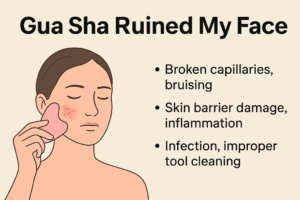
Do you know? Many people appear to have chubby faces not because of obesity? But due to improper functioning of the lymphatic system in their face and neck? When the lymphatic system is not working correctly, waste products and fluids in the body can’t be properly drained and metabolized. Leading to the accumulation of these substances in the face and causing facial puffiness. So, Do you wake up with a puffier face compared to before sleep? If so, you might to try facial lymphatic drainage massage. It might bring you unexpected results.
The Scientific Principles of Facial Lymphatic Drainage Massage
The scientific principles behind facial lymphatic drainage massage are based on the physiology of the lymphatic system and the effects of massage. It aiming to enhance the flow of lymphatic fluid for improved facial skin health and appearance. Here are the scientific principles of this massage:
- Importance of the Lymphatic System: The lymphatic system is a crucial part of the body, similar to the circulatory system, but it doesn’t transport oxygen to our bodies. Instead, it’s responsible for carrying lymphatic fluid, which contains white blood cells, waste, cell debris, and other metabolic byproducts. The lymphatic system aids in removing waste and toxins from the body while playing a crucial role in the immune system to fight infections and diseases.
- Dependency on Lymph Flow: Unlike the circulatory system, the lymphatic system lacks a heart to pump fluid. Lymphatic fluid flow depends on muscle contractions, breathing movements, and changes in body position. Therefore, when specific massage techniques are applied, they can stimulate lymphatic fluid flow, aiding in the removal of waste accumulated in tissues.
- Stimulation through Massage: Facial lymphatic drainage massage uses gentle techniques of massaging and tapping on the face and neck area to activate the lymphatic system. Massage increases local blood circulation and accelerates waste removal by stimulating the flow of lymphatic fluid.
- Reducing Facial Swelling and Edema: Lymphatic drainage massage can reduce facial edema and puffiness by aiding in the removal of excess fluid from the lymphatic system, thus improving facial contours and reducing swelling.
- Promoting Skin Health: By increasing blood flow and oxygen supply, facial lymphatic drainage massage can improve skin health. It also helps alleviate skin tightness, enhancing skin softness and radiance.
How to Perform Facial Lymphatic Massage
Performing facial lymphatic drainage massage requires gentle techniques to stimulate lymphatic fluid flow. It aiding in the removal of waste and toxins from facial tissues while avoiding skin damage. Here are the general steps to perform facial lymphatic drainage massage:
- Preparation:
- Cleansing: Ensure your hands and face are clean with no makeup or other substances remaining. You can use a gentle cleanser to clean your face and hands.
- Massage Oil: You can choose to use some massage oil such as olive oil, sweet almond oil, or coconut oil to help your fingers glide smoothly on the skin. This also helps keep the skin moisturized. Opt for a lightweight massage oil when possible.
- Massage:
Follow these steps for facial lymphatic drainage massage:
- Start from the Neck: Begin gently massaging upward from the neck area towards the chin using the pads of your fingers, not the fingertips, to avoid excessive pressure or scratching the skin.
- Jawline and Chin: Continue the upward massage towards the chin and jawline. Use gentle upward motions, repeating about 15 times.
- Cheekbones and Eye Area: Next, gently massage the cheekbone area. Start from the temples and then gently glide along the area below the eyebrows to the chin. You can lightly massage around the eyes, but be careful not to apply too much pressure.
- Behind the Ears: Massage gently from the temples to behind the ears. Many lymph nodes are located behind the ears, making this area particularly important.
- Chin and Mouth Corners: Use your fingertip pads to gently massage the chin and mouth corners to help promote lymphatic fluid flow.
- Nose and Forehead: Finally, gently massage the nose and forehead area, gliding upward towards the hairline.
- Gentle Tapping: You can use gentle tapping or patting motions to further stimulate the lymphatic fluid flow. Avoid vigorous tapping and maintain a gentle rhythm.
- Ending the Massage:
After completing the massage, you can rinse your face with lukewarm water and follow up with your regular skincare routine. The duration of the massage can vary based on personal preference and time availability, but it’s typically recommended to massage for 10 to 15 minutes.
Please note. When performing facial lymphatic drainage massage, you should use gentle techniques and avoid applying excessive pressure to prevent skin damage. If you are unsure about how to perform facial massage, it’s advisable to seek guidance from a professional masseur or esthetician or refer to relevant video tutorials. Additionally, if you have skin conditions or other health concerns, it’s best to consult a doctor before attempting facial massage.
Why Is Gua Sha Effective for Facial Lymphatic Massage?
Gua sha is an ancient Chinese therapeutic technique involving the use of specialized tools to scrape the skin to improve blood circulation and lymphatic flow. Gua sha is effective for facial lymphatic massage for several reasons:
- Stimulating Lymph Flow: Gua sha can promote the flow of lymphatic fluid by stimulating the lymphatic system. Thegua sha motion helps break up stagnation of lymphatic fluid in the lymphatic channels, aiding in the removal of waste and toxins.
- Increasing Blood Circulation: Gua sha simultaneously increases local blood circulation, supplying more oxygen and nutrients to facial skin, which can improve skin health and appearance.
- Reducing Facial Swelling: Gua sha can alleviate facial edema and puffiness by aiding in the elimination of excess fluid within the lymphatic system, resulting in a tighter and more youthful appearance.
- Stimulating Self-Healing: Gua sha stimulates the body’s own healing mechanisms by creating microtraumas on the surface of the skin. This promotes collagen production, improving skin texture and reducing wrinkles.
- Relaxing Tense Muscles: Gua sha can relax tense facial muscles, reducing stress and anxiety, which can enhance the appearance of the skin.
It’s important to note that gua sha should be performed with moderate pressure and proper technique to avoid skin abrasions or injury. It’s best to have gua sha performed by an experienced practitioner or a professional massage therapist. Gua sha may not be suitable for everyone, especially those with sensitive skin or specific skin conditions. So consulting a doctor before trying it is advisable. In summary, gua sha can be used as a supplementary skincare method when appropriate. But, should not replace traditional skincare routines.
Using Gua Sha for Facial Lymphatic Drainage Massage:
- Preparation:
- Before starting your Gua Sha massage, ensure that your skin and the Gua Sha tool are clean.
- You can also apply a small amount of facial oil or moisturizer to your skin to help the tool glide smoothly.
- Technique:
- Hold the Gua Sha tool at a 15-degree angle to your skin.
- Begin with gentle pressure and then gradually increase it if needed, but avoid excessive force.
- Use slow, deliberate strokes, always moving in an upward and outward direction, following the natural contours of your face.
- For each stroke, start from the neck area and move upward towards the chin, then from the chin to the jawline, and so on.
- Pay special attention to areas with lymph nodes, such as behind the ears and along the jawline, as this can help stimulate lymphatic flow.
- Facial Zones:
- Divide your face into different zones and spend a few minutes on each zone.
- For example, you can start with the neck, then move to the jawline, cheeks, under the eyes, forehead, and temples.
- Pressure Points:
- Gua Sha can also target specific acupressure points on the face to further enhance lymphatic drainage and relaxation.
- Gentle pressure on these points can help alleviate tension and improve energy flow.
- Repeat as Needed:
- You can repeat the Gua Sha massage as often as you like, but it’s generally recommended to do it 2-3 times a week for the best results.
- Post-Massage Care:
- After the Gua Sha massage, you can rinse your face with warm water and continue with your regular skincare routine.
- Be sure to clean the Gua Sha tool thoroughly after each use.
- Remember that consistency is key when it comes to facial lymphatic drainage massage with Gua Sha. Over time, you may notice improvements in facial puffiness, skin tone, and overall skin health.
In conclusion. Facial lymphatic drainage massage, whether performed using manual techniques or Gua Sha, offers potential benefits for improving facial appearance and skin health. However, it’s important to approach these techniques with care and ensure. They are done correctly to avoid any adverse effects. If you have any concerns about your skin or are unsure about how to perform these massages, it’s always a good idea to consult with a skincare professional or a qualified massage therapist for guidance and personalized recommendations.








